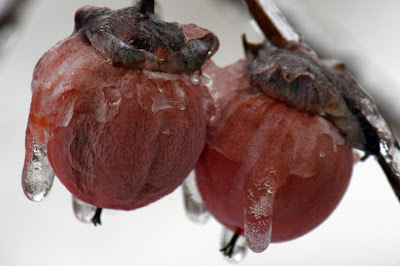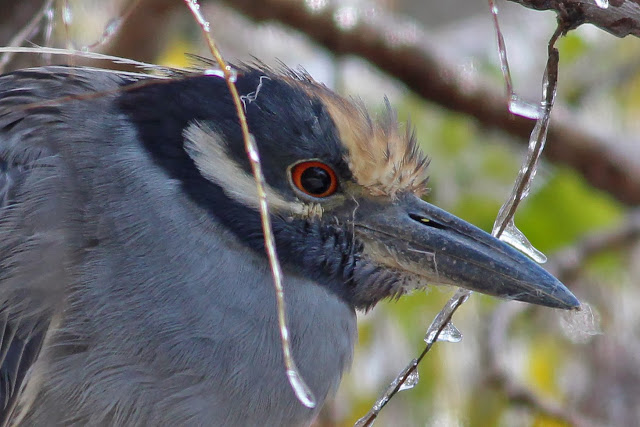Great Trinity Forest In Deep Freeze — Winter Forecasting With Persimmons
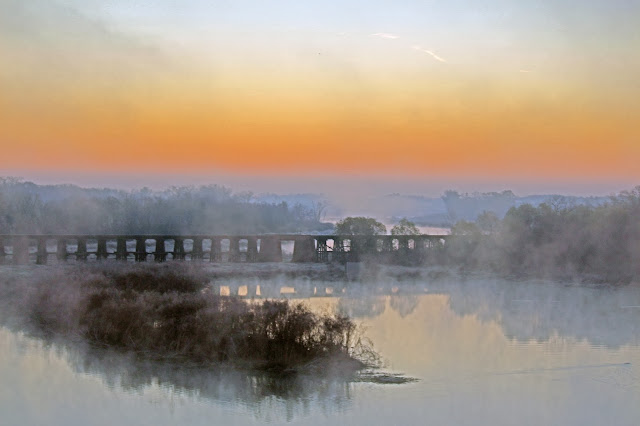 |
| Thick ice fog gathers at dawn along the Lower Chain of Wetlands |
Winter comes a little early to North Texas in 2013. A cold winter ahead maybe? The stories of West Nile Virus carrying mosquitoes are rotated out for that of white knuckle driving on Texas highest overpasses. What escapes many is that while the roads and sidewalks are a perilous method of travel, the natural surfaces are a great way to get out and wander. Some 85 degrees colder than many visits down here the often overlooked spots on the Trinity River really take on a new persona in the freezing conditions.
 |
| Union Pacific locomotive moving a load across the frozen Trinity River Bottoms in the Lower Chain of Wetlands |
Native Persimmon Seeds as a Winter Weather Forecast Tool Diospyros virginiana
 |
| Fruit of the Persimmon in the Great Trinity Forest Diospyros virginiana |
Growing wild across the Eastern half of Texas, the persimmon is an unassuming fruit tree. A “gatherer of possums” the Indians called them and tradition has it, a very old weather predictor.
The fruit appears as almost a round berry, about 1/2- to 1 inch in diameter. At first, the fruit is green. It changes to an amber color as it ripens and, then, in October, the ripe fruit often has a purplish tinge. A persimmon is very astringent before ripening. The skin will be wrinkled when the persimmon is ripe.
During the Civil War, Confederate soldiers boiled persimmon seeds to use as a substitute for coffee and used the seeds for uniform buttons. The American Indians made a bread from the persimmon fruit, which was eaten to stop dysentery. Although the common persimmon fruit never became popular with humans, it is a favorite of wildlife and is eaten by birds, especially crows, as well as wild hogs, squirrels, fox, raccoons, skunks, deer and, above all, the possum.
The astringent content of the persimmon is also so high, if you taste one, your mouth might be puckered up for a week. The first hard freezes change all that. The astringent alum is replaced with sugar and the texture of the fruit turns pulpy. The yellow coloring the fruit is gone and the color goes to a rich orange-red.
According to pioneer legend, persimmon seeds can be used to predict the severity of winter weather. When cut into two pieces, the persimmon seed will display on of three symbols. A knife shape will indicate a cold icy winter (where wind will cut through you like a knife). A fork shape indicates a mild winter. A spoon shape stands for a shovel to dig out the snow.
 |
| Two different persimmon seeds both showing “spoon” |
 After collecting a dozen seeds from 4 fruits and two different trees a mile apart, the verdict is 100% spoon. The seeds are cut open along the natural seam of the seed which is not much larger than that of a pumpkin.
After collecting a dozen seeds from 4 fruits and two different trees a mile apart, the verdict is 100% spoon. The seeds are cut open along the natural seam of the seed which is not much larger than that of a pumpkin.
The native range of the Persimmon is along the Virginias, Carolinas, Appalachians and Ozarks. Higher altitudes and areas prone to more fickle winter weather than Texas for sure.
The “spoon” tells us that Dallas would be prone to seeing snow this winter versus a mild winter. Our weather is pretty warm compared to other parts of the fruit tree’s range and might not be a good predictor. Interesting to see though. They are tasty too, like dates.
Big Spring –Nothing else like it in Dallas
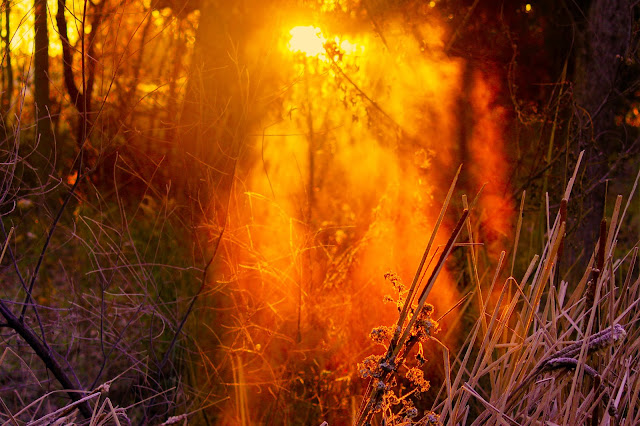 |
| Condensation rising from Big Spring in the Great Trinity Forest |
Few have laid eyes on a natural Texas spring, far fewer have seen the temperature differential create a foggy condensation develop around one in the early morning sunrise. Steam would be the wrong word to use here but it takes on the appearance of such.
 |
| Big Spring kicking out an impressive cloud of wispy fog and condensation from the head of the source |
The temperature of the water in Big Spring is constant year round in the upper 60s. With an air temperature in the low 20s and a windless sunrise, the spring breathes as if it were alive. The consistent water temperature and 23-25 gallons per minute of flow allow for the crayfish, mosquitofish and water plants to thrive all year long in the spring. When the areas around the spring freeze solid, the micro-climate cocoons the flora and fauna here.
 |
| Heavy frosted leaves near the spring created by the rolling fog of the warm water |
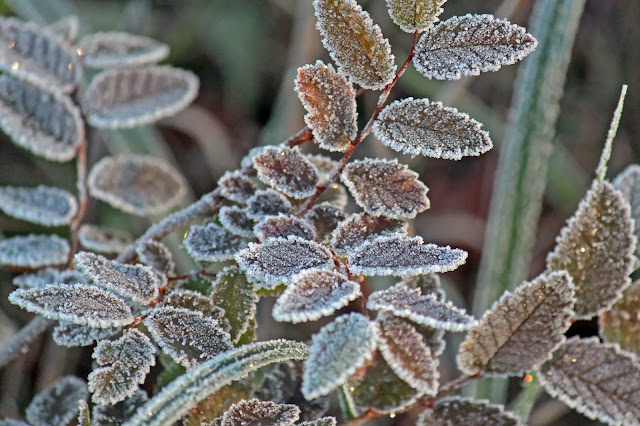 |
| Frozen leaves of a Cedar Elm sapling |
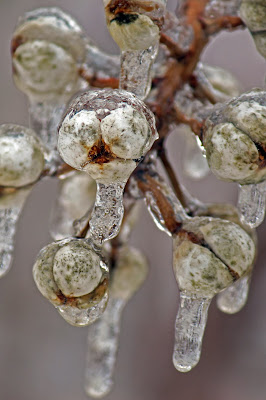 |
| Frozen Chinese Tallow Berries |
The protective blanket of the spring’s condensation only reaches so far. The plants within a stone’s throw are covered in heavy frost that more resembles coarse sugar or kosher salt. Heavy crystallized structures that glisten like jewels in the early morning light.
While many native trees flourish here so do invasive species. One such plant is a tree called the Chinese Tallow. Known as popcorn tree, chicken tree, or the Florida aspen, it is a tree that grows in well drained uplands and bottom lands, along lakeshores and on small islands. It is often used as an ornamental plant because it grows quickly and turns yellow to red in the fall. It grows to about 20 feet in height.
Used for twenty centuries, the Chinese Tallow Tree is native to southern China along the Yantgtze River Valley. It was introduced into the North America by Benjamin Franklin in 1772. He forwarded some seeds he got from what is now Vietnam and sent them to Mr. Noble Wimberly Jones, a horticultural enthusiast and gentleman farmer in Georgia.The introduction of the plant was hoped to spur a candle and soap industry in the United States.
Chinese tallow can invade a variety of habitats from sun to shade. The plant produces many thousands of seeds that may be carried by birds, and are easily spread. It may also live for weeks floating in water, and so can be dispersed great distances. It may also grow back from the stump or roots. Once established, it can crowd-out native species. They are also very difficult to kill. Also, the milky sap of the plant causes skin irritation. The leaves and fruit are toxic to cattle and cause nausea and vomiting in humans.
Plans are still being hacked out as how best to remove invasive species populations like the Chinese Tallow and Chinese Privet from areas around Big Spring. Dallas City Hall is floating the idea of a comprehensive management plan for the place. Which is a good idea as long as stakeholder input is the cornerstone of the initiative.
The photo above exemplifies the Pemberton family’s ties to the land and stewardship of Big Spring. For decades, for generations, they have enjoyed Big Spring, opened their farm to guests and given detailed tours of the environs. Above, in the left split, a younger Billy Ray Pemberton leans on the Black Walnut at Big Spring. Fast forward decades you still find the same man leaning on the same tree, the exact same way he always had. The 2013 photo of adult mountain bikers at right are the same age as the children in the photo to the left. Hard to say many places in Dallas look the same as they always have.
 |
| White Winged Dove in an icicle laden tallow tree |
White-winged Dove are another recent addition to North Texas. Not considered an invasive species like the tallow tree, they have slowly but surely extended their range north from the deserts of Mexico and the Lower Rio Grande Valley. The White-winged Dove is a bird whose range is largely south of the border through Mexico and Central America into western Panama. Seeing them in Dallas during an ice storm shows how out of place these subtropical birds are. Birds who struggle when the temperature drops below freezing.
The White-winged Doves are slightly larger and heavier than the similar Mourning Doves. Their rounded-off tail, and overall size, gives them a resemblance to a pigeon. White-wings are basically gray birds that can be told from Mourning Doves by their large white patches on the wings and broad white corners on their tails.
When perched, the white patches show as a white border along the folded wings. At close range you can see a featherless bright blue eye patch and yellow-orange to red-orange eyes.The head and nape of the neck are brownish with crowns of purple or red-purple. Iridescent flecks of gold, green and purple adorn the sides of the neck. The bright red legs and feet add a contrast to the basic gray, white and brown of the bird. The males and females are very alike. The slightly smaller females tend to have less purple and less iridescence.
 |
| White Winged Dove in an ice glazed Bur Oak |
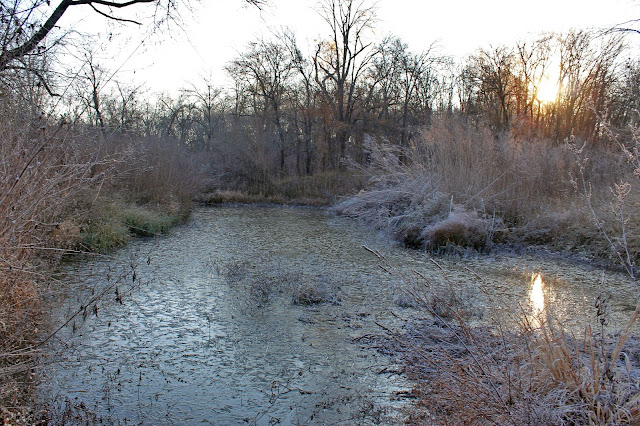 |
| A frozen Bryan’s Slough in the Great Trinity Forest |
Beyond the confines of Big Spring, the waters of Bryan’s Slough aka Oak Creek begin a slow meander to the southwest. Bryan’s Slough is named after John Neely Bryan the founder of Dallas he lived with his wife at Big Spring for some years before the Civil War. Creeks down here do peculiar things around each bend and Bryan’s Slough is no exception.
 |
| Mallards in the ice |
The real planners, engineers and builders in this part of town are the beavers. Here they have constructed large series of cascading beaver dams, beaver ponds and beaver slides which provide enormous biodiverse habitats for migrating waterfowl and other animals. One need only a scant understanding of hydrology to see the genius of these beavers at work.
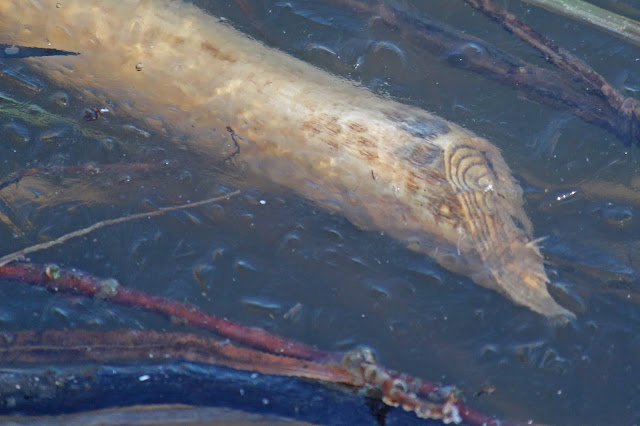 |
| Under a thick sheet of ice, a beaver whittled willow branch |
The beaver ponds down here hold water during times of summer drought and during the wet winter fan the waters of the slough out in every direction. In the past I have undone the work of a small section of a beaver dam, returning the next day to find it not only rebuilt but more fortified than before.
 |
| Frozen swamp near the confluence of White Rock Creek and Oak Creek in the Great Trinity Forest |
The slough as it travels further away from Big Spring becomes a water body vastly different than many would think. Not evidenced on maps or aerial imagery the slough takes the shape of a deep ravine with many turns, double backed twists and thick briar thickets.
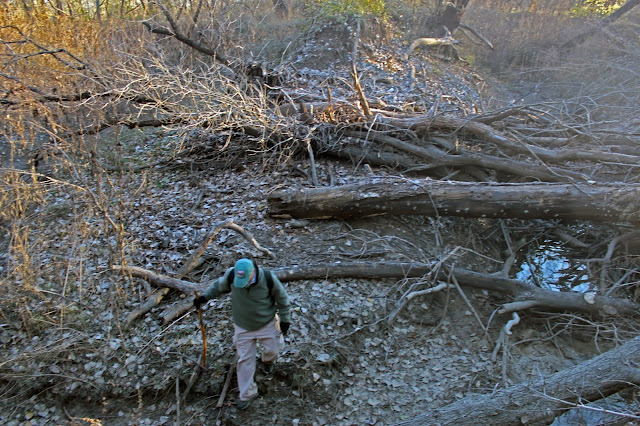 |
| The raft strewn gullies of lower Bryan’s Slough, southwest of Big Spring near the mouth of White Rock Creek |
The curse of violent flash flooding is laid bare around here. The large tree trunks and rafted limb debris that make crossing the slough difficult.
Here far away from where most would dare venture the deep woods of the Trinity River exist. Ones that scare many adults away for fear of what they might find. The rustle of the big black boar that haunts this place. The man sized fist of the coyotes. The loud calls of the raptors like the Red-Shouldered Hawk are all that pierce the quiet down here.
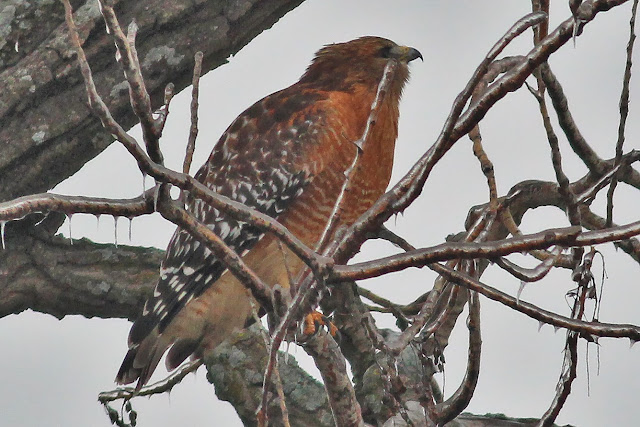 |
| Red Shouldered Hawk in a frozen Cottonwood tree |

The Red-Shouldered Hawk Buteo lineatus is a crow-sized soaring hawk. The adults are strikingly plumed, with rufous (brownish red) shoulder patches and a barred breast. Their upper wing coverts form the “red shoulders” evident on this species. The flight feathers of adults are barred black and white and show a white crescent-shaped window across the primaries, which is visible in flight. The underparts, which show white barring, often exhibit thin, dark streaks on the chest. The head and back are dark brown. The black tail is crossed by several narrow white bands. Although females average slightly larger than males, plumage is similar for both male and female. The call of the red-shouldered hawk is a series of nasal drawn-out “ aahhh ” cries.
Mature wet woods such as hardwood swamps and riparian forests typify red- shouldered hawk breeding habitat. Nesting territories, which occur in mixed woodlands, are typically located within remote and extensive old growth forests containing standing water. Consequently, breeding barred owls ( Strix varia ) and Cooper’s hawks.
 |
| Barred Owl December 2013 |
The Barred Owl is the nocturnal counterpart to the Red-Shouldered Hawk. Both birds occupy the same range in the eastern United States, prefer the same moist woodland habitats, and eat similar animals. The hawk is active during the day, and the owl is active at night.
The birds feed on a variety of small animals including mice, rats and squirrels. Distributed widely in the Eastern half of Texas they prefer large mature woodlands, marshes and stands of old growth trees. The larger trees are important to the Barred Owl as the old voids in the trunks provide nesting sites for their offspring. The Barred Owl will often take over old Red Shouldered Hawk nests as their own.
 |
| Eastern Bluebird on a frozen sycamore branch |
During the days of frontier settlement, the Eastern Bluebird Sialia sialis was among the wildlife species that benefited from the clearing of hardwoods in the Eastern US. The conversion of forest into pasture, orchards, and farms created an abundance of ideal bluebird habitat – open areas that supported the nesting and foraging activities of the species. Farmers unintentionally assisted bluebirds by bordering their fields with wooden fence posts, thus supplying additional nesting sites. Combined, these factors led to a proliferation of bluebird numbers throughout the eastern United States through the mid-1800s.
This situation changed in the late nineteenth century with the introduction of the European starling and the English house sparrow which adversely affected the native Eastern Bluebird population. Numbers dropped and only now are starting to see a large increase here in Texas.
 |
| Frozen willow branches |
Among the taller willows and the water loving tallows here, the Black Crowned Night Herons Nycticorax nycticorax roost on a communal basis in the winter. Forests, scrub /shrub, marshes, and ponds serve as nesting, roosting, and foraging habitats for black-crowned night-herons which favor this habitat.
 |
| Black Crowned Night Heron trying to balance on a frozen tallow tree |
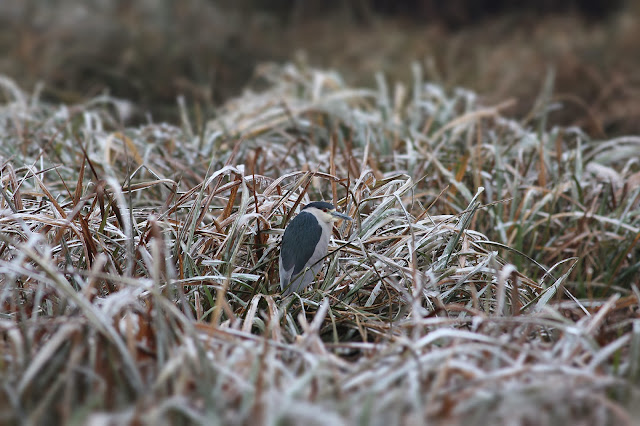 |
| Black Crowned Night Heron perched in frozen stiff cattails |
Year after year, the Black Crowned Night Herons come back to this spot. The shallow water mere inches deep extends like a shallow pool for many acres through a highly populated area of cattails, grasses and old logs.
The arrival of the Black Crowned Night Herons seems to coincide with the first hard freezes of the year that kill off many of the herons terrestrial prey. Crickets, grasshoppers and worms become non-existent after the freeze and the birds shift their hunting efforts to small fish in the shallow water.
.jpg) |
| Frozen leaves of a native Sweet Gum Tree Liquidambar styraciflua |
One unexpected sight is that of the Black Crowned Heron’s distant cousin, the Yellow Crowned Night Heron. Birds of the big swamps in southeastern United States they are a somewhat infrequent sight in Dallas. Like the White-winged Dove, seeing Yellow Crowned Night Herons in Dallas with the onset of winter is very odd.
 |
| Yellow Crowned Night Heron focused on fish in a swampy pool some 10 feet below the frozen willow used as a perch |
The Yellow-Crowned Night Heron Nyctanassa violacea is a migratory bird that traditionally lives along the Trinity River in Texas during the summer months. Customarily during the winter, it can be found as far south as South America, but can be found almost anywhere along the Gulf and Atlantic Coast year round. Unlike other night heron species, the yellow-crowned forages both late in the day and night. It forages much like other herons by wading through water waiting for its prey to come within striking distance.
 The prey of a Yellow Crowned Night Heron normally consists of fish, frogs, grasshoppers, and occasionally snakes, but its primary diet is crustaceans like crayfish.
The prey of a Yellow Crowned Night Heron normally consists of fish, frogs, grasshoppers, and occasionally snakes, but its primary diet is crustaceans like crayfish.
Yellow Crowned Night Herons are birds of the Old South and seeing one among the ice encrusted tree limbs of a willow has one wondering how cold a bird like this must be in 18 degree temperatures. If a bird ever looked cold, this one wins.
The Yellow Crowned Night Heron is a common wetland bird in the eastern half of Texas, but is listed as threatened in many of the states within its northeastern range. Loss of wetland habitat has had the greatest impact on this species. Continued conservation of wetland areas and development of new areas can help preserve the viewing of this species for many generations to come.
 |
| Yellow Rumped Warbler in a driving sleet storm, Great Trinity Forest, Dallas Texas |
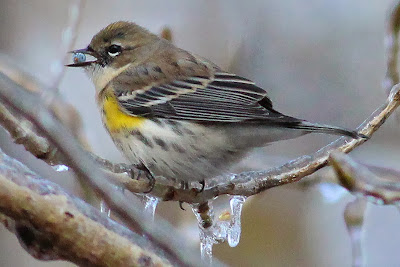 |
| Yellow Rumped Warbler eating the berry of a Mountain Cedar(juniper) |
Paruline à croupion jaune is the name the French who first settled New France in the Mississippi drainage gave this flighty little bird.
Now known as the Yellow-rumped Warbler Setophaga coronata it is one of the most common warblers in North America and the only warbler to regularly winter in Texas. It generally arrives in the state in late September and departs by mid-May. A couple of other warblers that migrate through the state have yellow rumps, but none of those rumps are as conspicuous.
This distinctive yellow rump-patch has led bird-minded folk to give it the affectionate name “butter-butt”. The broad breeding range of this bird stretches from Alaska south to Guatemala and east to the northeastern United States. It is often abundant in winter in the southern United States, and travels as far as Mexico and the western Caribbean. In Texas, it is commonly found in foraging flocks during winter months eating all from the same berry laden shrubs.
There are actually four variations of the species. Geographically separated from one another the various forms probably diverged when the eastern and western populations were separated in the last ice age.
 |
| Red-Bellied Woodpecker on a pecan tree |
Spotting woodpeckers down on the Trinity River is a real chore eight months out of the year. The brief Texas winters when the leaves are off the trees is the only time to get a good look at even the easiest to spot woodpeckers in the state, the Red-Bellied Woodpecker Melanerpes carolinus.
Red-bellied woodpeckers are adaptable to a variety of forested habitats. Though they are most commonly associated with mature hardwood forests, they also thrive in heavily timbered bottomlands, swampy woods, and riparian forests.
Two characteristics that distinguish red-bellied woodpeckers from other woodpeckers and often misidentified Sapsuckers native to Texas are the black and white zebra pattern on their backs, and the red belly.
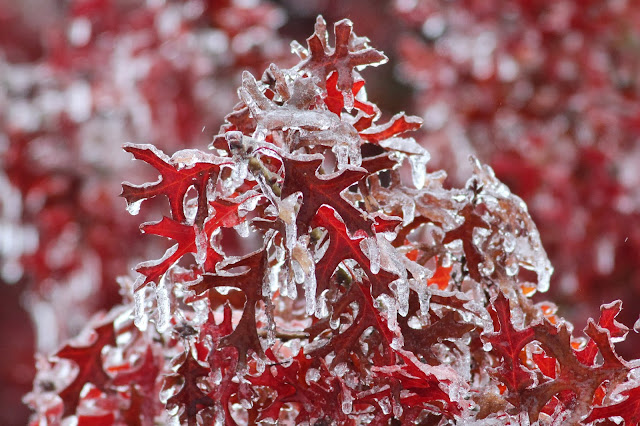 |
| A frozen Red Oak |
Red is traditionally a common theme on the Trinity River in December when the Red Oaks finally turn a dark red wine color. Many look forward to the lingering color the oaks afford. This year with the heavy ice many of those red leaves will most likely fall prematurely, snubbing those looking for winter color. The heavy cold wet weather is great for next years wildflower crop. If the wet weather continues it could be a banner year.
